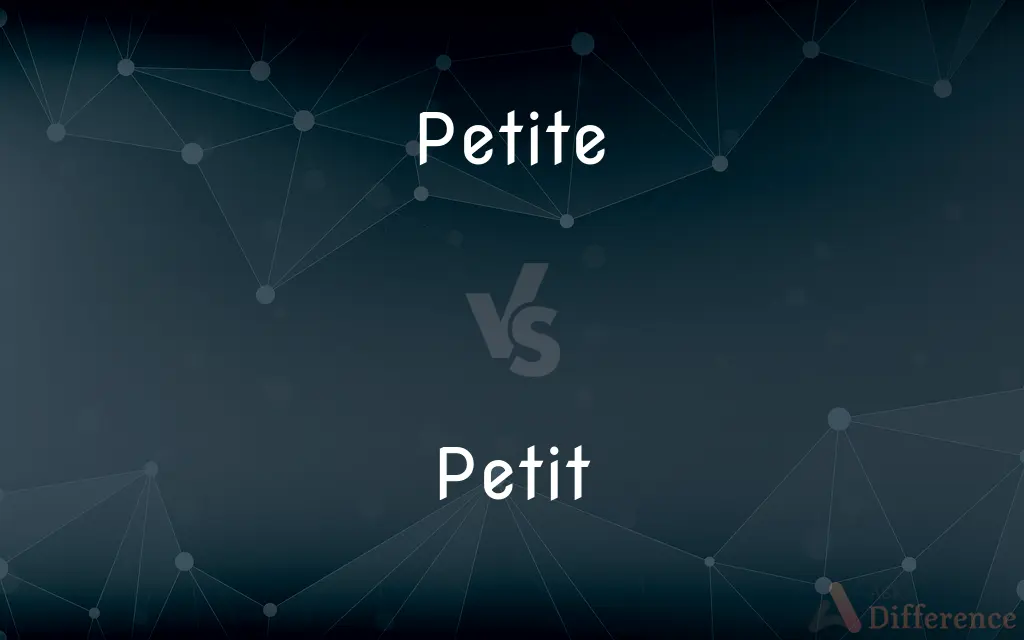Petite vs. Petit — What's the Difference?
By Tayyaba Rehman & Maham Liaqat — Updated on April 4, 2024
Petite refers to a small and slender figure, especially in women's clothing sizes, while petit is the French masculine form meaning small.

Difference Between Petite and Petit
Table of Contents
ADVERTISEMENT
Key Differences
Petite is commonly used in English to describe a small and slender body type, particularly in reference to women's fashion, where it denotes a specific size range designed for shorter women, whereas petit is the French word for 'small' and is used in masculine contexts in French.
While petite sizes in clothing are tailored to fit women under a certain height, typically 5'4" and under, with adjustments in proportions to fit the frame better, petit, when used in English contexts, often retains its French meaning and is usually seen in culinary terms, such as "petit fours" or in phrases borrowed from French, indicating something small in size or amount.
Petite emphasizes body proportions and height in a fashion context, offering a specific niche for clothing sizes, on the other hand, petit can refer to anything small in French, including objects, amounts, or sizes, without a specific focus on human body dimensions.
The use of petite in English has been standardized in the fashion industry to help women find clothes that fit more accurately according to their height and proportions, while petit, in its few English borrowings, is used more for stylistic or descriptive purposes, often maintaining a touch of French elegance or specificity.
In linguistic terms, petite is an adjective adapted into English from French, reflecting the feminine form of 'small', showcasing how language evolves and adopts foreign terms to fill specific descriptive needs, whereas petit as used in English, reflects a direct borrowing from French, maintaining its original spelling and masculine grammatical gender.
ADVERTISEMENT
Comparison Chart
Language
English, borrowed from French.
French (used in English in specific contexts).
Meaning
Small and slender, especially referring to women's sizes.
Small, masculine form in French.
Common Usage
Women's clothing sizes for shorter heights.
Descriptive term for small items or quantities in French contexts.
Focus
Body proportions and height.
General smallness.
Linguistic Role
Adjective adapted for specific use in English.
French masculine adjective, sometimes borrowed in English.
Compare with Definitions
Petite
Women's clothing size.
Petite sizes are designed for women 5'4 and under.
Petit
Borrowed from French.
English borrows the term petit for phrases that retain a touch of French.
Petite
Adapted into English from French.
The term petite has been fully adopted into English to describe certain body types.
Petit
Used stylistically in English.
Petit jury is used in legal terms to describe a trial jury, differentiating from a grand jury.
Petite
Specific to fashion industry.
The fashion industry categorizes certain sizes as petite for shorter women.
Petit
Masculine form of 'small' in French.
Petit gâteau means small cake in French.
Petite
Focus on fit and proportion.
Petite clothing is tailored for a better fit on shorter torsos and legs.
Petit
Used in English for culinary terms.
Petit fours are small bite-sized confections.
Petite
Small and slender figure.
She shops in the petite section because the clothes fit her small frame better.
Petit
Describes general smallness.
In French, petit can describe anything small, from a book to a car.
Petite
(of a woman) attractively small and dainty
She was petite and vivacious
Petit
(of a crime) petty
Petit larceny
Petite
Short and slender
This rack of clothing is for petite women.
Petit
Lesser in seriousness or scale.
Petite
Small in size or scope; tiny
“a bagel that is fairly petite by today's standards” (Ed Levine).
Petit
Petite: small, little.
Petite
A clothing size for short, slender women.
Petit
Petty, in its various senses:
Petite
(especially of a woman) fairly short and of slim build.
Petit
(obsolete) Few in number.
Petite
(clothing) of small size.
Petit
Unimportant; cheap; easily replaced.
Petite
Small, little; insignificant; petty.
Petit
Small, minor.
Petite
Small, little; of a woman or girl, of small size and trim figure.
Petit
Secondary; lower in rank.
Petite
A garment size for short or slender women
Petit
A little schoolboy.
Petite
Very small;
Diminutive in stature
A lilliputian chest of drawers
Her petite figure
Tiny feet
The flyspeck nation of Bahrain moved toward democracy
Petit
A kind of pigeon.
Petit
Synonym of brevier.
Petit
Small; little; insignificant; mean; - Same as Petty.
By what small, petit hints does the mind catch hold of and recover a vanishing notion.
Common Curiosities
Is "petit" used in English?
"Petit" is used in English, often in culinary terms like "petit fours" or borrowed phrases from French, retaining its meaning of 'small'.
What does "petite" mean in clothing?
In clothing, "petite" refers to sizes designed for women who are 5'4" and under, focusing on better fitting proportions.
How do you know if you should shop petite sizes?
If you are 5'4" or under and find regular sizes too long or ill-fitting in terms of proportions, petite sizes may offer a better fit.
Can men's clothing be petite?
Men's clothing typically doesn't use the term "petite"; it's mainly used in women's fashion to indicate smaller sizes for shorter women.
What is the difference between "petite" and "plus size"?
"Petite" refers to clothing for shorter women, regardless of their weight, while "plus size" refers to clothing for women who wear larger sizes.
What makes petite clothing different from regular sizes?
Petite clothing is designed with shorter lengths and proportions in mind, such as shorter torsos, arms, and legs, for a better fit.
Is there a children's clothing category called "petit"?
In English, children's clothing is typically categorized by age or size, not as "petit," which is more common in French.
Can "petit" describe people in French?
Yes, in French, "petit" can describe a small or short person, but it is the masculine form; "petite" would be used for females.
Can "petite" and "petit" be used interchangeably in English?
No, "petite" is specifically used for describing small and slender figures, mainly in women's fashion, while "petit" is a French term used in specific English contexts for small items or quantities.
Does "petit" have a feminine form in French?
Yes, in French, the feminine form of "petit" is "petite", used to describe small or short females.
Why is "petit" used in some English phrases?
"Petit" is used in English to add a French flair or precision to descriptions, often in culinary, legal, or stylistic contexts.
How do fashion brands determine petite sizing?
Fashion brands determine petite sizing based on average measurements and proportions of women 5'4" and under, focusing on a better fit.
Why do some English phrases retain French terms like "petit"?
Some English phrases retain French terms to preserve the original meaning, cultural significance, or because there's no exact English equivalent that captures the nuance.
Are all small pastries called "petit fours"?
Not all small pastries are called "petit fours"; the term specifically refers to small, bite-sized, fancy pastries often served at the end of a meal or with tea.
What are the challenges of shopping for petite sizes?
Challenges include limited availability, less variety in styles, and sometimes higher prices due to the specialized fitting and production.
Share Your Discovery

Previous Comparison
Discolouration vs. Discoloration
Next Comparison
Flippant vs. FlipAuthor Spotlight
Written by
Tayyaba RehmanTayyaba Rehman is a distinguished writer, currently serving as a primary contributor to askdifference.com. As a researcher in semantics and etymology, Tayyaba's passion for the complexity of languages and their distinctions has found a perfect home on the platform. Tayyaba delves into the intricacies of language, distinguishing between commonly confused words and phrases, thereby providing clarity for readers worldwide.
Co-written by
Maham Liaqat















































